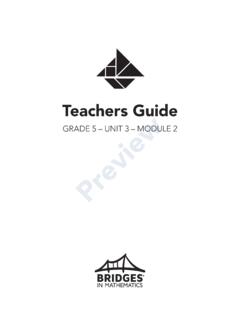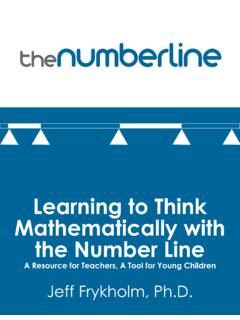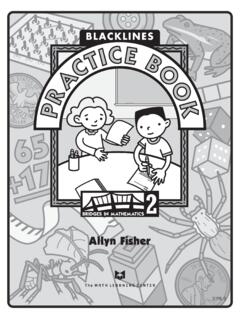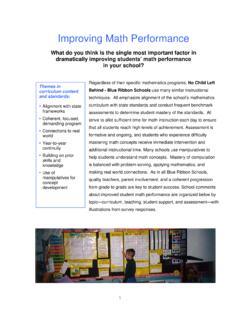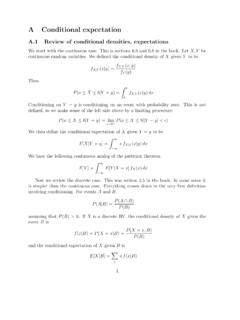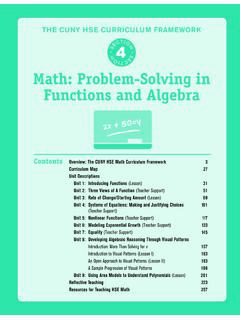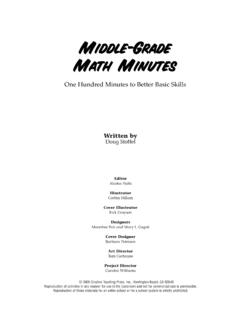Transcription of GRADE 5 SUPPLEMENT - The Math Learning Center
1 GRADE 5 SUPPLEMENTSet A12 Number & Operations: Dividing Fractions & Whole NumbersIncludes HMaking Sense of Division with Fractions HActivity 1: Dividing Fractions & Whole Numbers Pre-Assessment HActivity 2: Reviewing the Sharing & Grouping Interpretations of Division HActivity 3: Grouping Stories HActivity 4: Dividing a Whole Number by a Fraction HActivity 5: Sharing Stories HActivity 6: Dividing a Fraction by a Whole Number HActivity 7: The Division Poster Project HActivity 8: Dividing Fractions & Whole Numbers Post-Assessment HIndependent Worksheet 1: Sharing & Grouping: Multiplying & Dividing HIndependent Worksheet 2: Operating with Fractions & Whole Numbers HIndependent Worksheet 3.
2 More Fractions & Whole Numbers & Concepts HInterpret quotients of whole numbers HWrite story problems or describe problem situations to match a division expression or equation HMultiply a whole number by a fraction HSolve story problems involving multiplying a whole number or a fraction by a fraction HSolve story problems involving multiplication of fractions and mixed numbers HDivide a unit fraction by a whole number HDivide a whole number by a unit fraction HWrite story problems involving division of a unit fraction by a whole number HSolve story problems involving division of a unit fraction by a whole number HSolve story problems involving division of a whole number by a unit fractionP201304 Bridges in Mathematics GRADE 5 SupplementSet A12 Number and Operations: Dividing Fractions & Whole NumbersThe math Learning Center , PO Box 12929, Salem, Oregon 97309.
3 Tel. 1 800 575 8130. 2013 by The math Learning Center All rights for publication on Macintosh Desktop Publishing in the United States of math Learning Center grants permission to classroom teachers to reproduce blackline masters in appropriate quantities for their classroom in Mathematics is a standards-based K 5 curriculum that provides a unique blend of concept development and skills practice in the context of problem solving. It incorpo-rates the Number Corner, a collection of daily skill-building activities for math Learning Center is a nonprofit organization serving the education community. Our mission is to inspire and enable individuals to discover and develop their mathematical confidence and ability.
4 We offer innovative and standards-based professional development, curriculum, materials, and resources to support Learning and teaching. To find out more, visit us at A12 Number & Operations: Dividing Fractions & Whole Numbers The math Learning Center Bridges in Mathematics GRADE 5 SUPPLEMENT Background for the TeacherMaking Sense of Division with Fractions Division by fractions, the most complicated operation with the most complex numbers, can be consid-ered as a topic at the summit of arithmetic. Liping Ma (1999) Division of fractions is often considered the most mechanical and least understood topic in elementary school. Dina Tirosh (2000) Division of fractions often evokes anxiety in adults.
5 Many recall a process of inverting and multiplying but very few understand why that procedure works. By providing a three-year period Grades 5, 6, and 7 for students to learn to multiply and divide with fractions, the authors of the Common Core State Stan-dards aim to help generations of learners understand these operations. Their goals for fifth graders are limited and reasonable. Specifically, Common Core requires fifth GRADE students to: Interpret division of a fraction by a whole number and division of a whole number by a fraction by, for instance, writing story problems to match expressions such as 6 and 5. Compute such quotients using visual models to represent and solve the problems.
6 (Other than the expectation that students be able to write equations to represent story problems involving division of fractions, there is no call for specific numeric methods or algorithms.) Explain or confirm their answers by using the inverse relationship between multiplication and divi-sion ( , I know that 4 1 3 = 12 is correct because 12 1 3 = 4). In order to comprehend and solve problems such as 1 3 4 and 4 1 3, we have to understand that there are two different interpretations of division: sharing and grouping. When we interpret division as shar-ing (sometimes called equal sharing, fair sharing, or partitive division), we share out a quantity equally, as shown below at left.
7 We know how many groups we have to make ; we have to find out what the size of each group is. When we interpret division as grouping (sometimes called measurement or quotative division), we know what the size of each group is; we have to find out how many groups we can make given the dividend with which we re working, as shown below at right. 8 2 = 4 Sharing InterpretationHere we interpret 8 2 to mean 8 divided or shared evenly, as between 2 InterpretationIn this interpretation of 8 2, we determine how many groups of 2 we can make with that the answer is the same in both interpretations, but it means something different in each case. In the sharing interpretation of division the result of dividing 8 by 2 tells us the size of each group; Bridges in Mathematics GRADE 5 SUPPLEMENT The math Learning CenterSet A12 Number & Operations: Dividing Fractions & Whole Numberseach person getting 4.
8 In the grouping interpretation, we already know the size of the group 2. The re-sult of dividing 8 by 2 tells us how many groups of 2 are in 8. (There are 4.). The importance of knowing and understanding both interpretations of division cannot be overstated be-cause both are required to make sense of division with fractions. Consider the following: 4 1 3. If you read this expression and try to grapple with it in any kind of sensible way, the sharing interpretation of division seems unreasonable. How do you equally share 4 things with a third of a person? On the other hand, the grouping interpretation makes better sense. How many groups of one-third can you get from 4? In other words, how many thirds are there in 4?
9 We can reason that there are 3 thirds in 1, so there must be 4 3 or 12 thirds in 4. We can solve the problem sensibly without resorting to inverting and multiplying. In fact, there are a couple of visual models that make it possible for fifth graders to picture and solve the problem, as shown 13 Grouping Interpretation of Division (Measurement or Quotative Division)I have 4 cups of trail mix. How many cup sacks can I make with this amount of trail mix?Basic Question: I know what size my groups (servings) many groups (servings) can I make ? Suggested Models: Number Line or Discrete Objects 1301234131313131313131313131313I can make twelve one-third cup sacks with 4 cups of trail mix.
10 There are 3 thirds in each cup, so I can see there are 12 thirds in 4 cups. That means I can makeTwelve one-third cup servings with 4 cups of trail mix. I can also see that 4 = 12 because 12 thirds add up to 4, or 12 = 413131 cup1 cup1 cup1 cupWhat about 1 3 4? Can we use the grouping interpretation of division to help evaluate this expression? How many groups of 4 can you take out of 1 3? Since that makes little sense, what about the sharing in-terpretation? Is it possible to divide 1 3 into 4 equal shares? If you divide 1 3 into 4 equal shares, each share is 1 12. This may seem more difficult than figuring out how many thirds there are in 4, but a visual similar to the geoboard model students encountered in SUPPLEMENT Set A9 for multiplying fractions en-ables fifth graders to represent and solve situations that involve dividing a fraction by a whole number, as shown for the Teacher Making Sense of Division with Fractions (cont.)





